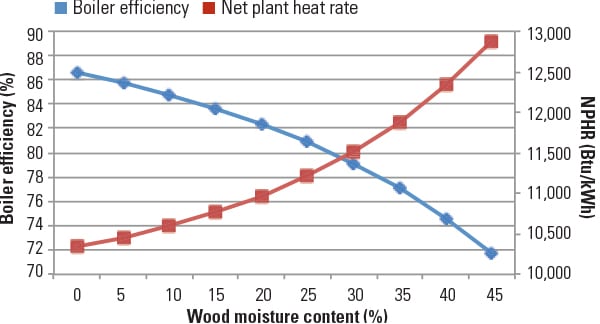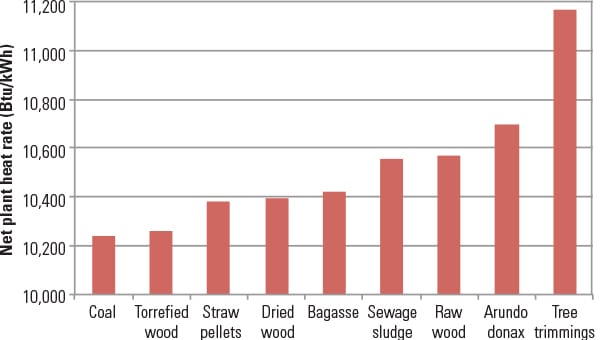Utility Biomass Use: Turning Over a New Leaf?
Once thought to be an excellent method for reducing emissions at coal power plants, biomass generation is still underutilized in the U.S. Inexpensive natural gas, lack of government incentives, and power plant operations concerns have limited biomass use at the utility level. Despite these challenges, biomass has several advantages that can be leveraged in certain situations.
If there is one truth to the power industry, it is that environmental regulations will only proceed down one path—that of stricter limits. Although legislatures and courts may argue over the issue for years to come, it appears inevitable that at some point a carbon or greenhouse gas (GHG) emissions tax will be applied to utility generators in the U.S. Countries that are subject to a carbon tax typically employ three solutions to reduce GHG emissions: improving plant efficiency via capital improvements plus monitoring and diagnostic tools, converting some or all of the coal generation to natural gas, or finding ways to utilize biomass fuel instead of coal.
Previous articles have examined the benefits of natural gas and monitoring and diagnostic programs; this article examines the options available to successfully utilize biomass at coal-fired power plants.
Even without GHG regulations for existing plants, current emissions requirements can make biomass cofiring or conversion attractive. For example, Portland General Electric’s (PGE) Boardman Coal Plant is a 585-MW pulverized coal plant that has fallen under environmental regulations, leaving its owners only three options: install expensive back-end emissions controls, close the plant completely, or switch to an environmentally friendly fuel. As a result, PGE has studied the option of reducing unit output to 300 MW and burning up to 18 types of biomass for a total coal to biomass conversion. “We at PGE are really excited to have this opportunity to keep a facility operational and maintain jobs, and help the environment at the same time,” said Randy Curtis, engineering supervisor at Boardman.
Current Status of Biomass Utilization at Utility Power Plants
Although biomass use is not uncommon among industrial units, and is the norm within the pulp and paper industry, biomass utilization for grid-connected utility-scale generation is rare in the U.S. According to the Federal Energy Regulatory Commission (FERC), operating biomass power capacity is only 15.8 GW, representing 1.4% of the total U.S. generation mix. Interest in biomass cofiring or conversion peaked in the early 2000s and has only been seriously pursued at utility scale at a handful of U.S. locations.
One notable installation was the AES Greenidge plant, near Dresden, N.Y., which employed a “homemade” biomass direct injection system that allowed the operators to burn approximately 10% biomass with coal (Figure 1). Typically using waste food or crop residues as fuel, Greenidge was closed in 2012, the victim of cheap natural gas and environmental concerns.
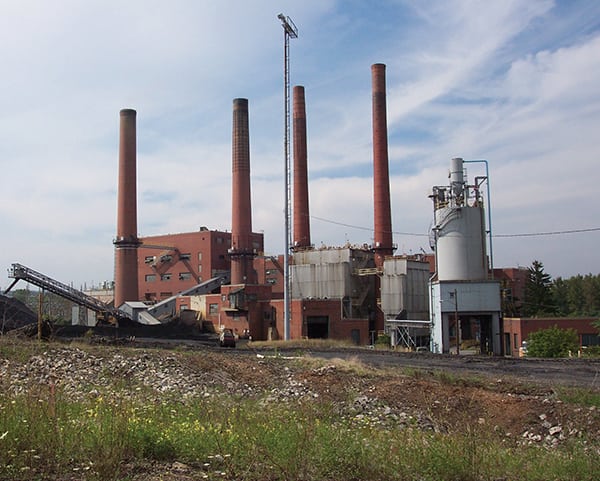 |
| 1. A worthy effort. During its operating life, the AES Greenidge plant demonstrated that biomass cofiring does not need to be expensive or complicated. Source: Black & Veatch |
According to Dave O’Connor, biomass program manager at the Electric Power Research Institute (EPRI), “the primary barrier to biomass cofiring or conversion in the United States is low natural gas prices. Power plants with convenient natural gas access face lower capital barriers to natural gas cofiring than biomass cofiring. In addition to this barrier, most renewable portfolio standards for non-utilities are already fully subscribed.”
Interest in biomass for utility-scale power is much greater outside of the U.S., with Europe and the developing world being the leaders in this field. (See also “Fuel-Flexible CFBs Add Flexibility to Resource Plans” in this issue.) One of the most notable biomass cofiring success stories to date has been the cofiring and conversion work at the 3,960-MW Drax Power Station in the United Kingdom. (For more on Drax, see “UK Struggles to Attract Low-Carbon Investment” in this issue.) The station has been working toward a goal to reduce GHG emissions by more than 70% and has explored burning several biomass fuels, such as willow, straw and wood pellets, and agricultural waste. The current plan is to convert three of the six units at Drax to being exclusively biomass by 2016; the Unit 2 conversion is already complete.
Biomass Cofiring Project Challenges and Pitfalls
Biomass utilization at existing coal-fired power plants can be implemented by several methods, from cofiring biomass and coal simultaneously to complete unit conversions to biomass combustion. Less-common methods of utilizing biomass include substituting B99 biodiesel for startup fuel oil, using a gasifier to feed hot fuel gas into an existing boiler, or even employing a separate standalone biomass unit to supply heat to the coal unit’s steam cycle.
In the last two decades Black & Veatch has studied the barriers to and concerns over utilizing biomass at more than 70 fossil-fired units (see sidebar). The following details some of the most common challenges we have encountered.
Biomass Supply. Finding a suitable biomass fuel supply at a competitive price is difficult for most power plants. Suppliers are often small “mom and pop companies” and geographically remote from the power plant. Supplies can be variable from a single vendor, mandating contracts with scores of small biomass suppliers, which greatly complicates the biomass procurement process. Sometimes biomass suppliers will promise to meet a demand for biomass at a reasonable price during a study, but once the project appears to be proceeding toward a test burn, suddenly the price will increase by 50% or more.
One solution to these problems is for the utility to take ownership of its biomass fuel. Such is the case with Drax Power, which is building biomass pellet plants in Louisiana and Mississippi and shipping pellets back to North Yorkshire, England. Designed to produce more than 900,000 tons per year of wood pellets, these pellet plants are a first step toward Drax’s ultimate goal of producing 2 million tons per year.
Biomass storage and handling logistics can be a serious concern for power plants with limited fuel yard space. Given a woody biomass of a typical moisture content, one rule of thumb is to assume that 1 ton per hour of biomass will be required for 1 MWh of power generation (less for pellets or torrefied biomass and more for wet, herbaceous biomass).
Biomass is typically delivered by truck, and a typical biomass truck can hold from 25 to 35 tons of biomass. Trucks tend to operate on a 10-hour schedule for six days a week; therefore, converting 10% of a 250-MW power plant to biomass will require about two to three biomass truck deliveries per hour. Local residents may object to that much truck traffic on the roads, and as a result the utility may be asked to pay for upgrading bridges and roads.
Trucks will require a rapid dumping system in order to avoid traffic congestion at the plant and may require a “staging area” be built by the plant entrance to hold trucks during temporary outages (Figure 5).
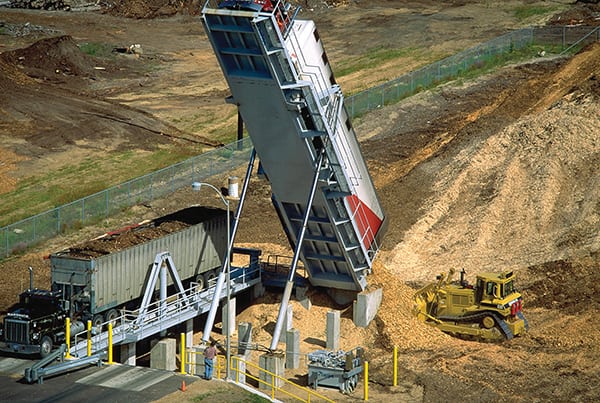 |
| 5. Rapid dumping. Parallel unloading systems may be required to avoid traffic congestion from biomass trucks. Source: Black & Veatch |
Biomass Storage. Biomass storage is often problematic at coal-fired power plants. Because biomass fuels come in a variety of types and sizes, plant owners must design their storage and reclaim systems with care. Covered biomass storage is recommended or required for most fuels to reduce reclaim efforts and to protect the biomass from degrading. Pelletized biomass is often touted as being “rain-hardy,” but experience has shown that a single rainstorm can sometimes transform a pile of biomass pellets into a mountain of sludge. Thus, covered storage is highly recommended.
Another concern with biomass storage is the high levels of dust created during handling, especially at transfer points. Biomass dust is generally less harmful to humans and the environment than coal dust, but it can be susceptible to hazardous mold accumulation, which can affect the health of both the fuel yard staff and nearby residents. Compared to coal, biomass dust is significantly more fire-prone due to its relatively low ignition temperatures. This risk was exemplified by the 2008 biomass dust explosion at the Ontario Power Generation Atikokan plant. Four years later, a biomass fire among the wood pellets stored in 600–metric ton hoppers at the Tilbury B power plant in the UK led to that plant being out of service for nearly four months.
Although coal demand will decrease as it is replaced with biomass, biomass fuel has a much lower energy density than coal, and more of it is required for the same net generation. For a unit currently burning an 11,000 Btu/lb coal, cofiring just 5% straw biomass containing 40% moisture will require a biomass storage area 80% as large as the current coal pile!
Comilling and Direct Injection. Many technologies are available for introducing biomass into a coal-fired boiler. Direct injection of ground biomass into the furnace via dedicated ports is one of the safest methods for cofiring, although it is also one of the most expensive.
For small quantities of biomass fuel (1% to 5% by energy content) comilling can be the best choice, provided your mills are up to the task. Due to the slippery and plastic nature of biomass materials, milling with a roll-wheel mill or ball tube mill can be problematic. Although the Hardgrove Grindability (HGI) test is not intended to measure the grindability of biomass materials, a rule of thumb is to assume herbaceous biomass has an HGI of 20 to 25.
As part of a biomass project that Black & Veatch was involved with in conjunction with Genesis Energy, New Zealand, at its Huntly power station, the engineering and corporate staff showed exceptional diligence in planning for comilling of up to 20% biomass. Here are some of the recommendations of that study:
■ Biomass fuel can stick in bunker hoppers and clog feeders, requiring vibratory shakers or even redesign of the hoppers. In some cases biomass fuel can jam feeders and trip a mill.
■ Increased housekeeping should be implemented to control dust and spilled fuel from the tripper to the feeders. Improved fire detection and suppression systems may be needed for the coal conveyors, tripper room, and bunkers.
■ Mill roll wheels can be modified with slots cut into them, to give the wheels more “bite” into the biomass fuel. Roller spring adjustments may also be required.
■ Ball tube mills may find many biomass fuels problematic and, therefore, may require additional vigilance to ensure that the fuel and balls don’t conglomerate together into a solid mass.
■ Classifier settings will need adjustment for biomass use, with some plant engineers opting to open up classifiers to avoid accumulating stringy, oversized biomass.
■ Mill air flow must be checked, and air gaps closed, to prevent under-bowl fires.
■ Primary air ducts should be checked to ensure light biomass dust does not backflow and accumulate in expansion joints, leading to a potential fire or explosion risk.
■ Mill inerting and fire detection systems are necessary for any long-term biomass comilling program. Special care should be taken to sweep mills clean of biomass material during shutdown.
Direct injection of biomass can be into the existing coal pipes downstream of the mill or be introduced directly to the furnace via ports or burners. In the former method, no new furnace penetrations are required, the unit maintains its full coal capacity, and the capital cost is modest. In the case of direct injection into the furnace, the greatest concerns are triggering New Source Review by cutting new fuel ports into the walls, and potential space limitations that prevent optimum biomass port or burner placement.
Whether biomass direct injection occurs in the coal pipes or the furnace proper, it is important to try to maintain a consistent biomass quality and quantity entering the furnace, so operators are able to keep the units tuned for the best balance of unburned carbon, CO, NOX, and furnace deposition.
Boiler Concerns. Many biomass fuels can reduce boiler maintenance activities by having a low, nonabrasive ash content. Some biomass ash has a lower melting point than coal ash, which can result in slagging on water wall surfaces. Biomass ash with a high potassium or sodium content can significantly foul heat transfer tubes in the upper furnace region.
Due to biomass having a lower energy density than most coals, introducing significant amounts of biomass fuel into a furnace can result in increased flue gas velocity and, potentially, more tube erosion in the close-spaced primary superheater and economizer tube bundles. Excess tube corrosion can occur with high-chlorine biomass fuels, especially those with a dry-basis chlorine content of 0.18% or greater.
Ash-Handling Equipment. Dry ash-handling systems can benefit from the relatively low ash content of biomass. However, biomass ash that contains high levels of calcium and magnesium can encourage cementation in wet ash systems.
Another potential problem concerns power plants that sell their fly ash for concrete use. Currently, the ASTM C618-12a standard for fly ash used in concrete does not allow the introduction of biomass ash to the mix. In addition, the chemical requirements of ASTM C618-12a may not allow biomass ash to be classified as Class N, C, or F fly ash.
In one biomass cofiring study at large coal power plant, it was quickly discovered that if the utility must pay to have its ash landfilled, as opposed to selling nearly all of its ash, the differential cost to the plant was a loss of more than $5 million per year.
Emissions Controls. At biomass cofiring levels of 10% or less by heat input, most electrostatic precipitators (ESPs) can successfully collect biomass ash. However, some biomass produces ash that has either a very high or very low resistivity, thus making it difficult to collect.
This is often the case in studies at power plants designed for high-sulfur coals, and significant levels of biomass cofiring may require either ESP upgrades or chemical injection. Furthermore, unless the furnace combustion and milling systems are well tuned for both the coal and biomass, boiler fly ash unburned carbon can greatly increase. This is a problem for two reasons. First, high levels of unburned carbon can change the ash resistivity and increase ash re-entrainment after being collected in the ESP. Second, biomass ash with high amounts of unburned carbon can accumulate in hoppers or in fabric filter baghouses, leading to sometimes destructive fires.
Although biomass combustion often reduces NOx emissions, selective catalytic reduction (SCR) catalysts can be very sensitive to heavy metals and alkaline earth elements contained in biomass. If the biomass in question includes a significant amount of post-industrial waste, it can sometimes contain arsenic, lead, cadmium, potassium, and other items harmful to catalyst life. Where high levels of ammonia slip are encountered with either an SCR or a selective noncatalytic reduction system, biomass ash can agglomerate and form tenacious deposits on air heaters downstream (Figure 6).
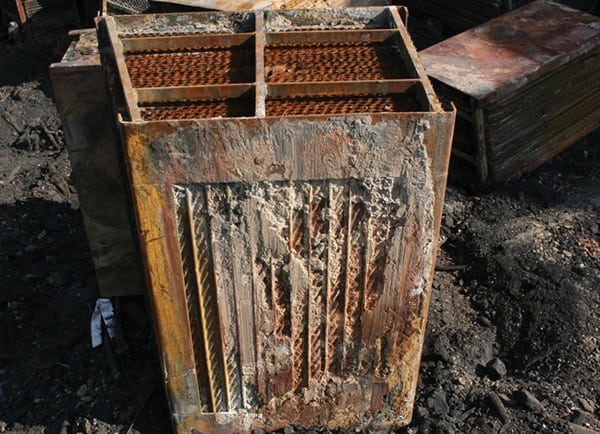 |
| 6. Air heater fouling. High levels of ammonia slip can agglomerate biomass ash on air heater baskets. Controlling ammonia distribution to the furnace or selective catalytic reduction system is critical for avoiding this problem. Source: Black & Veatch |
Flue gas desulfurization scrubbers are not normally sensitive to biomass ash, unless the ash contains excessive amounts of chlorine. Some herbaceous biomass ash can contain more than 0.5% chlorine, whereas many scrubbers have a fuel-based chlorine limit of less than 0.2%.
Greenhouse Gas Emissions. Biomass fuel is rarely 100% carbon neutral, and calculating the life-cycle GHG emissions from biomass cofiring or conversion can be quite difficult, especially when one considers all of the possible feedstocks.
The planting and growing cycle, fertilizer use, harvesting, transportation, milling and processing, and transportation to the power plant all contain numerous assumptions that will differ from study to study. A review of 12 studies published in the past three years regarding the net change in GHG emissions at cofiring facilities found that the carbon neutrality of biomass fuels ranged from 40% to 96.5%. Clearly, a life-cycle assessment is required for any proposed biomass cofiring or conversion scheme.
Engineered Biomass Fuels
Most biomass fuels suffer from three fuel properties that limit their use at existing coal-fired power plants: low energy density, high moisture content, and poor grindability. All of these limitations can be addressed via the use of engineered biomass fuels. Engineered biomass fuels can be created by many different processes—including torrefaction, steam exploding, and processing with waste heat—but the net results are very similar.
Typically, a large amount of moisture is driven off the fuel, significantly increasing the heating value, while the chemical structure of the fuel itself is altered such that the biomass becomes more friable and easy to grind in a coal mill. Some processes even promise sulfur, chlorine, and heavy metal removal as part of the upgrading.
The primary drawbacks to engineered biomass fuels are their price and availability. Availability is a function of the market being in its infancy, and price is a result of both handling the fuel twice and the energy and materials used in the upgrade process. Unfortunately, in most cases, engineered biomass products cannot compete with coal without some special legal, environmental, or political incentive at work.
EPRI’s O’Connor is bullish on upgraded biomass. “Torrefied, steam-exploded, and other upgraded biomass products can usually be burned at existing coal-fired power plants with relatively minor modifications. The problem is operating cost—finding an upgraded biomass which can meet environmental goals economically.” But, O’Connor cautions, “ensuring sustainable biomass is the critical thing. A lot of the pellet production is from waste wood or wood unsuitable for other uses. Biomass resource planning needs a sound strategy for sustainability to keep the process as carbon-neutral as possible.”
Can Biomass Blossom?
Although several potential pitfalls have been discussed in this article, few should be considered fatal flaws in a plan for biomass cofiring or biomass conversion. Though it is true that cheap natural gas currently dampens the enthusiasm for biomass, many power plants have no suitable gas supply options. Furthermore, many power plants located in remote regions or on island nations operate in circumstances where even engineered biomass fuel is less expensive than imported fossil fuels. Some power plants are located near plentiful biomass sources, and others have the ability to produce their own fuel.
So, despite the pitfalls, the net effect is that biomass use is increasing for electrical generation, even in the U.S. According to FERC, 219 MW of biomass capacity were added in 2013. Should a GHG emissions or carbon tax be levied in the future, or the price of gas increase significantly, then using biomass may be an option a utility can’t ignore. ■
— Una Nowling, PE ([email protected]) is a project manager and technology lead for fuels at Black & Veatch. She has worked on fuels-related issues and analyses at more than 550 different units over 20 years, specializing in coal, natural gas, and biofuels. She is also an adjunct professor of mechanical engineering at University of Missouri-Kansas City.

